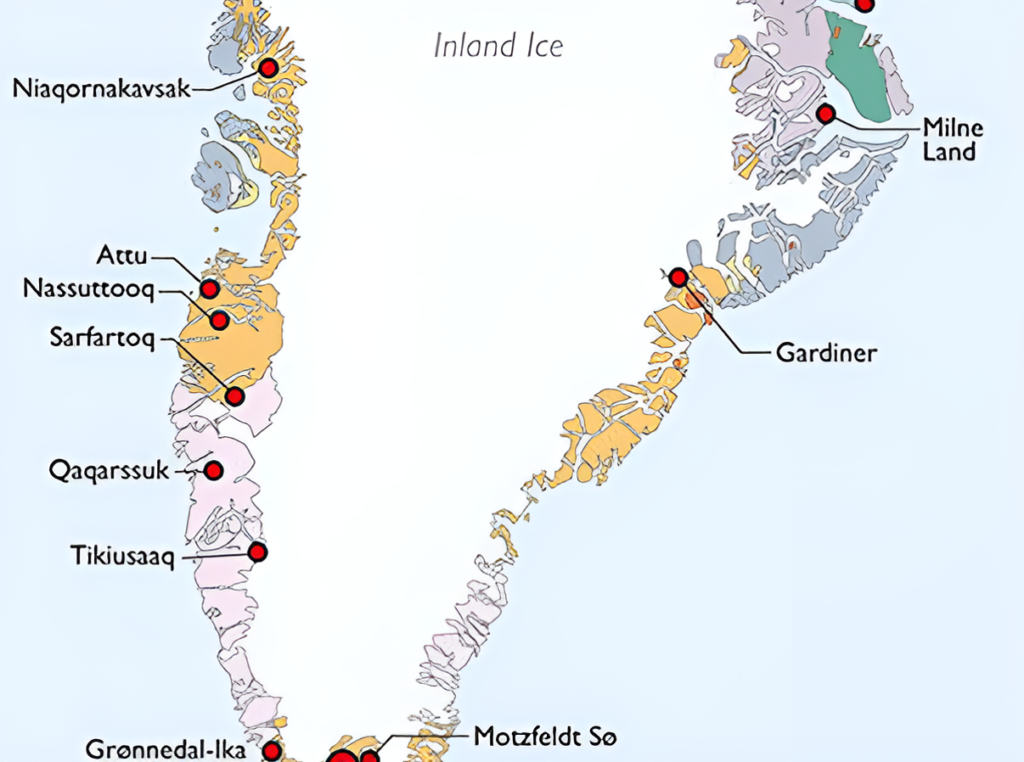The large Danish island holds key resources for current technology, which are still difficult to exploit due to the permanent ice sheet and an extreme climate.
Before returning to the White House, Donald Trump has already stirred up international politics with his ambitions for Greenland’s annexation. During his previous term, he suggested that he could buy this gigantic island from Denmark. Now, he does not rule out imposing tariffs on the Nordic country to force them to yield it — or even using military force. Numerous analysts have explained in recent days the strategic importance of this territory — especially if maritime trade opens up through an ice-free Arctic — and the U.S. president-elect himself claims that it is essential for his country’s “economic security.” What exactly is he referring to?
Although Greenland has fewer than 60,000 inhabitants, its land area is four times larger than Spain. Eighty-four percent is permanently covered by ice, but this white mantle is retreating and hides treasures that world powers have coveted for centuries — such as gold and oil — and others that are key in the 21st century: some of the most promising rare earth deposits in the world. These elements are essential for all modern technology, but some are quite scarce, and China holds an almost total monopoly on extraction, processing, and supply chains.
Years ago, the Kvanefjeld mining project, near Narsaq — a town of 1,700 inhabitants located at the southern tip of the island — sparked enormous controversy. Led by an Australian company, it aimed to extract rare earths and uranium, but strong social opposition halted the initiative. In 2021, a new law from Greenland’s autonomous government established a series of requirements for mining extractions that, in practice, ended this project. However, the reserves remain, and some expect that new times may bring regulatory changes. In fact, a Chinese investor joined the Australian company.
What Greenland Holds:
Studies indicate that Kvanefjeld is the second-largest rare earth deposit in the world and the sixth-largest in uranium. Moreover, due to its location, it is one of the most accessible sites on the island. However, there are many more resources to be exploited on this island. The EuRare project, funded by the European Union, has studied the rare earths available in European territory, and the outlook is quite bleak — except for a couple of exceptions: Kiruna in Sweden and Greenland, especially its west coast, which concentrates most of the island’s sparse population. Geologists estimate that the probability of finding rare earths in profitable concentrations is very high at several points.

Rare earths located in Greenland. (©GEUS / EuRare Project)
Rare earths are a group of 17 elements, and some are especially important for magnet production (praseodymium, neodymium, samarium, dysprosium, and thulium). This means they are present in any electronic device, “from a car windshield wiper to a wind turbine or a drone,” says Ricardo Prego, a CSIC scientist and author of the book Las tierras raras, in statements to El Confidencial. In reality, all technology from the last 60 years depends on these components, but the electrification of the economy and the popularization of high-tech products like computers and mobile phones have caused demand to skyrocket, while deposits remain scarce for the most part.
Even when located, the process of obtaining the desired elements is long, complex, and costly. “One thing is having the mine, and another is carrying out the processing. You need to bring the ore, separate it from the gangue, obtain rare earth oxide, and purify it depending on the intended application,” explains the expert. That is why “Europe is totally dependent on China,” because besides lacking raw materials, it has almost no treatment centers — with Estonia being the only exception.
In this regard, the U.S. does have some rare earths, but China’s advantage in such a crucial matter is immense. Greenland would be an opportunity to change things in the medium or long term since “from the discovery of a potential deposit to its exploitation, 10 years can pass,” Prego points out. In this case, the unknowns would be even greater due to various factors — from the precedent of social and political opposition to the Kvanefjeld project to the natural difficulties of the environment. In fact, much remains unknown about the island’s resources because the coastal area is well-mapped, but “under the ice, there could be many things that are not yet known.”
Melting Changes Everything
The issue is that accessing all these strategic resources will become increasingly easier. The main reason is a factor that many Trump voters dismiss or even deny: climate change. Data shows that the world’s largest island is one of the fastest-warming regions globally. “Since 1995, the average temperature has risen by 1.5ºC compared to the rest of the 20th century; this means that in 30 years, it has increased as much as the entire planet in a century and a half,” explains Nacho López, a researcher at the Pyrenean Institute of Ecology (IPE), a CSIC center based in Zaragoza.
As a result, Greenland’s polar ice cap — the second-largest ice mass after Antarctica — is melting, along with other peripheral glaciers. “The ice is disappearing very quickly,” highlights the expert, who visits the island periodically for his research work. “It’s a hotspot both for ice loss and for the quality of its resources,” he adds. However, in the interior, the thickness of this ice layer is between two and three kilometers deep.
That volume is so gigantic that it is unthinkable that it will disappear in a short period, but scientists warn that we are increasingly closer to reaching a point of no return where temperatures could rise irreversibly. Specifically, some studies indicate that warming between 1.7ºC and 2.3ºC would trigger a much faster process. “Changes happen progressively, but once a certain threshold is crossed, they accelerate dramatically. We are not far from exceeding that barrier and seeing everything speed up significantly,” says the IPE scientist.
In fact, this region of the planet has already experienced incredibly rapid ice reductions in the past, “because it is very sensitive to warming processes.” A study published in Science in 2023 revealed that northwest Greenland — a remote and inaccessible area near the pole — lost all its ice about 400,000 years ago, “when the average global air temperature was similar to what we will soon experience due to human-induced climate warming,” the authors detailed.
Climate and Extraction
In recent years, the changes are already more than visible. From 1980 to the present, about 30,000 square kilometers have become ice-free — an area as large as Galicia and Catalonia combined. “It’s a very considerable area, but if we cross the acceleration thresholds, it will multiply quickly,” says the CSIC researcher. Additionally, warming also means less sea ice — an issue widely discussed regarding the opening of Arctic shipping routes, but also fundamental for facilitating access to seabed mining resources.
However, warming also affects other aspects, and in these latitudes of the American continent, weather is key for any activity. “The snow cover lasts less time, and this, for a hypothetical resource exploitation, leaves a longer period each year to work,” highlights Nacho López, who has developed a research project focused precisely on the temperature-induced variations in the western Greenland snowpack.
Aside from the frozen terrain, Greenland’s climate is “very limiting for extractions; although it doesn’t make them impossible, it makes them difficult.” Only the central summer months are relatively mild, while life becomes much harsher starting in September. Therefore, a possible reduction in snow duration in the coming decades — even by just a couple of months per year — “would leave a lot of room.” In that regard, CSIC studies highlight a significant increase in ice and snow melting across the island.
In any case, the repercussions of all these changes regarding the exploitation of Greenland’s resources are “more in the medium term than immediate,” assures the expert. In fact, some reports state that “in the coming years, exploitation possibilities are limited,” but it is clear that major powers are trying to secure the future.






0 Comments